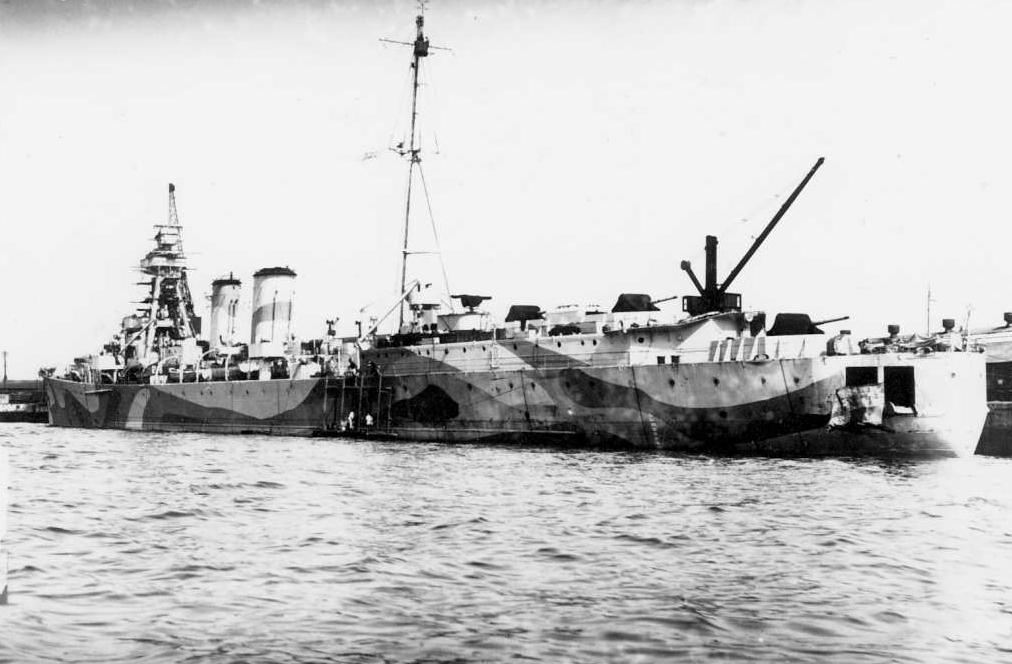
HMS Adventure (ML-1926)
Back to Commonwealth Ships List
The Adventure class ships were designed and built for offensive minelaying, but they ended up being to slow for that. Designed at a stage when cruisers were making 28-29 knots, the Admiralty designers felt that a sea speed of 30 knots of a ship the size of the Adventures would be more than enough for their purpose. Within 5 years the two ships were obsolete. The Treaty heavy cruisers making 32-to-35 knots and the advent of aircraft making over 200 mph killed off their role as offensive minelayers. Instead they were used to close as many of the exits from the North Sea as possible. To do this in a reasonable period of time a huge mine deck was fitted capable of taking 400+ mines. This would be done in conjunction with other converted minelayers (destroyers and cruisers). These were the replacements for the Princess class ships sold to Australis.

Please note that the mine shown at the mine door is for display only, it would not normally be visible. Both ships were slated for reconstruction 1939-40. Arrogant was taken in hand in July 1939, with the removal of the big, heavy, 4.7" AA guns, plenty of weight was made available for new armaments and electronic fittings. Four twin 4" were fitted giving a much better AA battery than the cumbersome 4.7". An extra pair of quad 2 pounder AA mounts were fitted amidships with all three mountings having predictors fitted to help control them. 20mm cannons were fitted in single and twin mountings wherever these could be fitted. The Adventure (above) never got to have its refit and fought WW2 with its antiquated main weapons.

The Arrogant was used in the Western Mediterranean, where its heavy AA battery
gave it a chance to survive. Laying minefields along the African coastline, in
the hope of sinking a few ships staying inshore. Laying the defensive minefields
around Gibraltar. Its main role after the entry of Italy into the war was to
help keep Malta supplied with urgent supplies. It was after the fourth run to
Malta, for the Arrogant, that German bombers caught the ship in harbour and sunk
it.
| Displacement | 6750 tons std, 8600 tons full load. | |
| Length | 517 ft | |
| Breadth | 58 ft | |
| Draught | 17 ft | |
| Machinery | 2 shaft Steam turbines, 50,000shp | |
| Speed | 30 knots | |
| Range | 6000 miles at 12 knots, 2100 @ 25 knots | |
| Armament | 6 x 4.7" (6x1) 4 x 2pd (1x4) 12 x 20mm (12x1) |
8 x 4" (4x2) 12 x 2pd (3x4) 16 x 20mm (6x2, 4x1) |
| Mines | 300 large 400 small | |
| Complement | 550 | |
| Notes | HMS Adventure (1926) 1945 reserve status,
sold for scrap 1947 HMS Arrogant (1928) sunk 1941 at Malta in shallow water after delivering urgent supplies. The wreck was still able to use its AA guns in support of the Island. Broken up in situ 1948. |
|
Service record of HMS Adventure.
Laid down at Devonport in November 1922, launched in June
1924,
and commissioned in October
1926,
Adventure was the first vessel built for service as a minelayer, she was
also the first warship to use diesel engines, being used for cruising.
On entering the service she joined the Atlantic Fleet. From 1931-1932, she underwent a refit. During this refit she received a rounded stern in place of the original square one.
In the early months of the Second World War, she was damaged in the Thames Estuary and was repaired at Sheerness.
In 1940, she laid minefields in the Orkney Islands and St. George's Channel and in 1941 was damaged by a mine while off Liverpool.
In 1944, she was converted to a landing craft repair and accommodation ship; in 1945 was reduced to reserve; and in 1947 was sold to Thos W Ward. and broken up at Briton Ferry.
